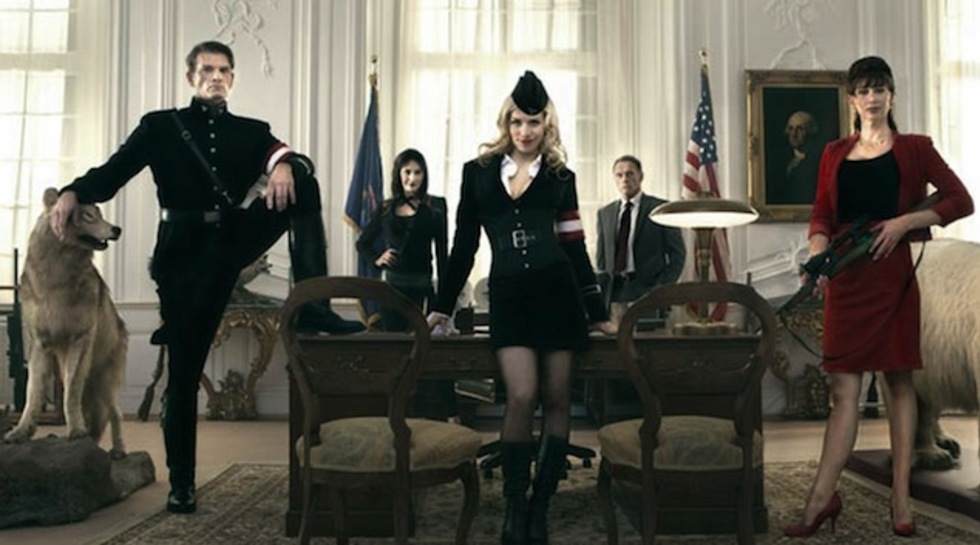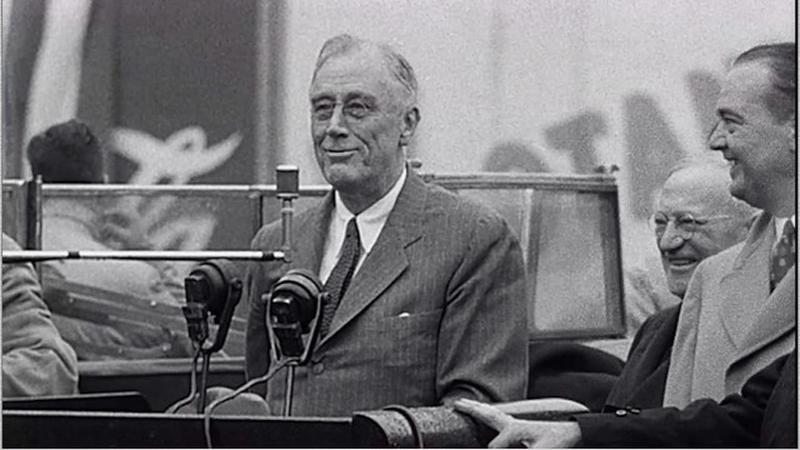For a time, everything that producers Aaron Spelling and Leonard Goldberg touched turned to gold. Seventies’ gold—which makes it open-shirt, heavy-link, neck-chain gold, meaning Spelling and Goldberg managed to tap into the viewing public’s penchant for kitschy melodrama infused with a heavy-metal dose of camp. They straddled the one-hour drama and half-hour comedy genres, turning out “Starsky and Hutch” (1975), “Charlie’s Angels” (1976), “The Love Boat” (1977), and “Fantasy Island” (1978) in rapid succession.
The year that “Fantasy Island” debuted, “Charlie’s Angels” finished #4 in the Nielsens, while “The Love Boat” cruised in at #14 with Mr. Roark and Tattoo following in their wake at #17—the highest the show would place.
Though “Fantasy Island” was popular for a time—Consider how many can still visualize little person Hervé Villechaize pointing to the sky and shouting, “Da plane! Da plane!”—Villechaize’s departure from the show and the writers’ pandering to the public’s sense that Fantasy Island host Mr. Roark (Ricardo Montalban) had a dark side eventually led to a ratings drop and the show’s demise. It also hurt that the producers kept reusing the same stars, so that their characters and performances seemed even more difficult to believe.
Like “The Love Boat,” and before that, “Love, American Style,” the format called for several plots to be showcased in a single episode. When the show officially became a mid-season replacement, the producers scaled back to two plotlines for the remaining and that’s what we get in Season 2.
It was pure “Gilligan’s Island” mind-numbing escapism, with plane after plane of B-list celebrities visiting the island to have their wildest fantasies fulfilled. That was part of the fun, in fact, seeing who would turn up on the set. It was like a light-drama version of “Hollywood Squares” with its rotating stars. But the moral was always “be careful what you wish for,” because once a fantasy was set in motion, Mr. Roarke’s disclaimer was that he could not be responsible for the way things played out. “Do you still want to do this?” he’d ask every guest whose fantasy had a dangerous element to it. The plots resolved themselves way too quickly most of the time, so it felt like the kind of fantasy you have in a dream that you barely remember. Guests kept turning up again in different roles, and the same fantasies started to be reused. But the formula is right there on the surface, and so none of the plot lines carry much surprise with the baggage that visitors bring to the island. In truth, many of the episodes are so obvious and the acting so B-level that they can become tedious as quickly as you can say “Da plane! Da plane!” Or “Da hot air balloon,” which producers also tried this season.
Season 2 guest stars include Elvira, Sonny Bono, John Astin, Jonathan Frakes, Playboy playmate Barbi Benton, Cyd Charisse, Michelle Pfeiffer, Leslie Nielsen, Mamie Van Doren, Don KNotts, Cesar Romero, Janet Leigh, Toni Tenille (sans the Captain), Mary Ann Mobley, Roddy McDowell, Annette Funicello, Regis Phhilbin, Danny Bonaduce, Darren McGavin, Anne Francis, Shelley Fabares (who turns up in quite a few episodes), Desi Arnaz Jr., Arte Johnson, Dan Rowan, Red Buttons (another repeat customer), Connie Stevens, Peter Graves, Phil Silvers, Eva Gabor, George Maharis, Larry Storch and Forrest Tucker, Rue McClanahan, Scott Baio, Tracey Gold, Jill Whelan, and pretty much everyone from the old “Brady Bunch” TV show (Robert Reed, Florence Henderson, Maureen McCormick, and Eve Plumb in separate episodes).
This is the season in which little Tattoo speeds around the island in his own miniature version of the safari-style car that Mr. Roarke picked up guests in. And it’s the season in which little person Billy Barty turned up and ended up scuffling with Tattoo.
Here are the 25 episodes included:
- “The Sheikh / The Homecoming.” A schoolteacher wishes for a harem and gets more than he bargained for; and a Vietnam vet presumed dead wants a reunion with his family, even though his wife is remarried and his children don’t know him anymore.
- “Big Dipper / The Pirate.” A girl with a pickpocket for a father seeks a normal life; meanwhile, a man fantasizes about swashbuckling his ex-wife away from a new man she might marry.
- “The Beachcomber / The Last Whodunit.” A man wants to get away from it all and a mystery reader wants to solve the murder of her favorite author.
- “The Best Seller / The Tomb.” A writer wants a best seller and an archaeologist wants a big dig.
- “I Want to Get Married / The Jewel Thief.” Yeah, they’re that obvious. The titles pretty much say it all.
- “The War Games / Queen of the Boston Bruisers.” A Vietnam vet challenges another vet to a competition; meanwhile, it’s a roller derby queen tries to pass herself off as a lady to impress her daughter’s future inlaws (Apple Annie, anyone?).
- “Let the Good Times Roll / Nightmare / The Tiger.” A hot-rod racer wants to relive the old days; a newlywed is having nightmares that might destroy her marriage; and an adventure writer stalks a mythic creature called the Jamporie.
- “Return / The Toughest Man Alive.” A woman returns to Fantasy Island to declare her love for Mr. Roarke; and an average guy wants to be a hero.
- “The Appointment / Mr. Tattoo.” A doctor with not enough time for his patients tries to get a computer to run things; meanwhile, two women want Tattoo to help them find millionaires to marry.
- “Island of Lost Women / The Flight of the Great Yellow Bird.” A sailor wants to discover a mythic island of beautiful women, and a professor and an adventurer seek bigfoot.
- “Carnival / The Vaudevillians.” A woman in a coma believes that the man of her dreams is real; and a couple of old hoofers try to bring back the old act to avoid a retirement home.
- “Charlie’s Cherubs / Stalag 3.” Three secretaries aspire to be Angels, with Tattoo as Bosley. And four WWII vets relive their days in a POW camp and their escape.
- “Vampire / The Lady and the Longhorn.” An actor prepares to play Dracula in an unorthodox way; a businesswoman wants a millionaire to save her company from ruin.
- “Seance / The Treasure.” A seance reveals a murder; and a marriage is jeopardized by money.
- “Cowboy / Substitute Wife.” A rodeo clown claims he was a star; and a hypochondriac who thinks she’s dying seeks a new mate for her husband.
- “Photographs / Royal Flush.” A photographer is haunted by the image of an unknown figure in one of her photos; and a gambler wants to be the best poker player in the world.
- “The Stripper / The Boxer.” An update on “It Happened One Night” finds a rich girl having to pose as a stripper; a man with a terminal illness wants a chance at a title fight he might not get otherwise.
- “Pentagram / A Little Ball / Casting Director.” A TV reporter finds people close to her are dying; a nun’s faith is tested; and women try to bribe a director with, well, you know.
- “Spending Spree / The Hunted.” Two friends get a half million to spend; and the hunter becomes the hunted in yet another version of “The Most Dangerous Game.”
- “The Birthday Party / Ghost Breaker.” A woman forced to give up her twins wants to meet them on their 30th birthdays; a man who wants to publish a book on ghostbusting needs to gain experience.
- “Yesterday’s Love / Fountain of Youth.” A couple on the brink of divorce goes back to the WWII USO club where they first met; an old man pays millions to an adventurer to get him a canteen from the Fountain of Youth.
- “The Comic / Golden Hour.” A comedy writer wants to be a stand-up comic like hs boss; and a crippled pen pal finally meets a prison inmate.
- “Cornelius and Alphonse / The Choice.” In a version of O. Henry’s “Ransom of Red Chief,” a couple of petty criminals take tattoo hostage and wish they hadn’t. Meanwhile, two orphans get to pick their own parents.
- “Bowling / Command Performance.” An amateur bowler gets the chance to bowl with the best; a retired circus owner gets the old show together, only one of the acts now wants her dead.
- “Amusement Park / Rock Stars.” A boy wants to run a park and hire his estranged father to work there. Meanwhile, four kids who think their parents are dead look to find fame and fortune as a rock band.
There are 19 hours of episodes, most of them mildly entertaining, all of them hokey, and some of them so bad they’re laughable—which is the epitome of camp. For a time “Fantasy Island” was a part of American pop culture, and there’s still an audience for it. Not a big audience, mind you, or else it wouldn’t have been seven years between the release of Season 1 and Season 2. Sony put out the first volume, and as often happens with classic television, it’s Shout! Factory to the rescue for fans who’ve been waiting for Season 2.
Video:
There’s nothing fancy or special about the video presentation. It is what it is, and that’s pretty typical of ‘70s shows. Colors are vivid and accurate, as are flesh tones, and that’s surprising, given the color stock of the era. There’s grain and a slight breakdown on the edges, but that’s to be expected for standard def TV shows. “Fantasy Island” is presented in 1.33:1 aspect ratio, and it looks fine stretched to fill a 16×9 monitor.
Audio:
Here too, the audio is acceptable, but if it’s Dolby Digital 2.0 Stereo, there’s very little separation. I can’t even tell, with my ears to the speakers, whether it’s mono or stereo. Thankfully, except for the well-known theme song and musical segues, it’s all dialogue and sound effects.
Extras:
Nothing fancy: just a Dolby Digital 2.0 Mono.
Bottom Line:
As much as the characters on “Fantasy Island,” viewers were able to escape each week for an hour of light entertainment and melodrama. Some of the episodes were fluffy as meringue, and others tried to be dark as “The Twilight Zone.” There wasn’t an original idea on display, but fans tuned in because they knew exactly what they were getting. And really, as much as Mr. Roarke and Tattoo, it was the revolving door of B-list guest stars that made the show fun to watch.


